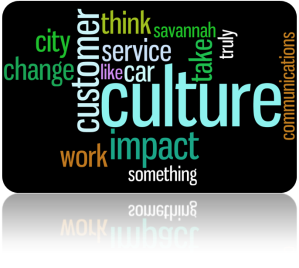 In the recent WTOC story City Council discusses budget, customer service, the City of Savannah is highlighted for their initiative to change the culture of the organization. They plan to setup rate-your-service kiosks and put everyone through customer service training. While these are positive actions to take, there has to be more, right?
In the recent WTOC story City Council discusses budget, customer service, the City of Savannah is highlighted for their initiative to change the culture of the organization. They plan to setup rate-your-service kiosks and put everyone through customer service training. While these are positive actions to take, there has to be more, right?
When you think about a culture, you think about “how things work around here,” you think about how decisions are made, how relationships work, how communications flow, what it’s really like to work at the City of Savannah. So what impacts that?
The organization’s Mission, Vision, and Core Values impact that; leadership has the biggest impact on that culture. Reward/recognition systems, accountability based on well-documented and well-communicated customer service standards impact that culture. The organizational structure, workflow processes, who and how they hire, and internal and external communications impact culture. And yes, measurement is important, but how are they creating a consistent dialogue with residents to truly know and act on the “Voice of the Customer?”
Too many organizations take an approach to changing culture that is like putting new tires on your car; the new tires make the car look a little fresher and shinier, but they haven’t impacted what truly makes the car go.
When you are looking to change culture, realize that you’re about to undertake something important, something big!
Take a comprehensive approach to culture change.
Did you like this post? Here are other Government-related posts:






















